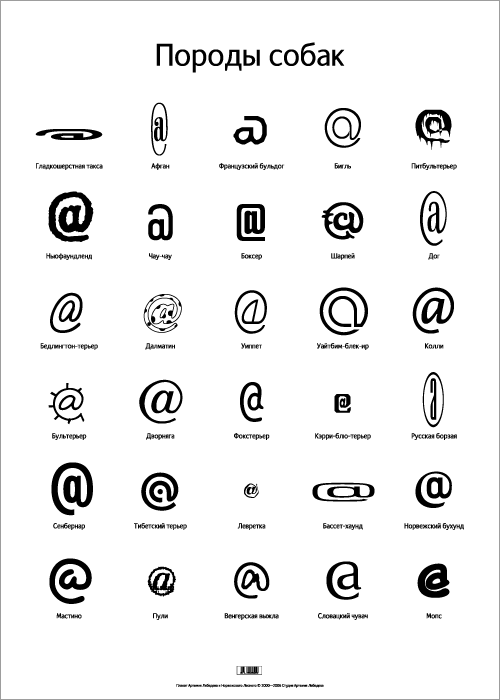http://store.artlebedev.ru/catalog/posters/dogs/
Also, for reference, from http://www.netlingo.com/lookup.cfm?term=%40
@
(pronounced: at -or- the at sign -or- the at symbol)
Computer engineer Ray Tomlinson is credited with inventing the @ symbol for e-mail in late 1971, when he grappled with how to properly address what would be history's very first e-mail. Many languages have developed colloquial names for the @ sign which, for some reason, have food or animal references. Check it out:
In Russian it is 'little dog.' (or simply 'dog')
In German, it is frequently called Klammeraffe, 'spider monkey' (you can imagine the monkey's tail).
In South Africa, it means 'monkey's tail.'
The Danish refer to it as grisehale, 'pig's tail' but more commonly calls it snabel, 'an elephant's trunk' (as do the Swedish, where snabel is the name recommended by the Swedish Language Board). Danes also refer to it as the 'alpha sign.'
Dutch uses apestaart or apestaartje, '(little) monkey's tail,' this turns up in Friesian as apesturtsje and in Swedish and Finnish in the form apinanhanta.
Finnish also uses kissanhanta, 'cat's tail' and miukumauku, 'the miaow sign.'
The French often refer to it as 'little snail.'
In Hungarian it is kukac, which means 'worm' or 'maggot.'
In Poland it is 'little cat' or 'pig's ear.'
In Serbian is is majmun, 'monkey', with a similar term in Bulgarian.
In Bosnia, Croatia, and Serbia it's called the 'crazy.'
Both Spanish and Portuguese use arroba, which derives from a unit of weight.
In Thai, the name transliterates as 'the wiggling worm-like character.'
Czechs often call it zavinac which is a 'rolled-up herring' or 'rollmop.'
The most-used Hebrew term is 'strudel,' from the famous Viennese rolled-up apple sweet.
Another common Swedish name is kanelbulle, 'cinnamon bun', which is rolled up in a similar way.
In the Czech Republic, it is 'pickled herring.'
The Turks lovingly describe it as an 'ear.'
In Greece, it is 'little duck.'
In Mandarin Chinese, it is the 'mouse sign.'



 LinkBack URL
LinkBack URL About LinkBacks
About LinkBacks






 Reply With Quote
Reply With Quote
